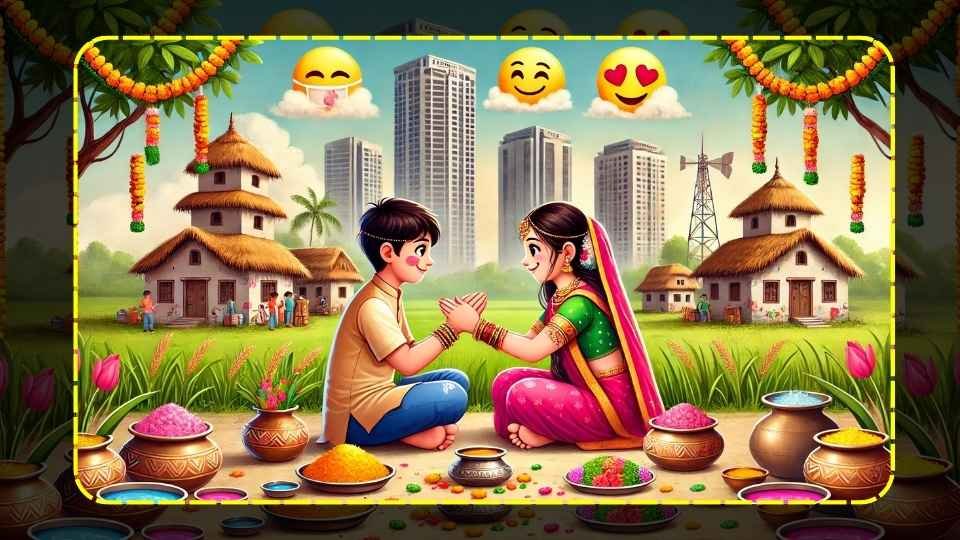Bhai Dooj, celebrated on the second day after Diwali, is a revered festival in Indian culture. Dedicated to the sacred bond between brothers and sisters, Bhai Dooj has its roots in ancient mythology, and the customs associated with it are celebrated with deep respect across India. This festival strengthens the commitment between siblings to care for, support, and protect each other. In this article, we’ll delve into the rich history, stories, and interesting anecdotes surrounding Bhai Dooj.
Traditional Bhai Dooj celebration with tilak ceremony, siblings exchanging blessings, capturing the cultural heritage and love of this ancient festival

1. Origins of Bhai Dooj 🏵️
Bhai Dooj, also known as Bhaiya Dooj, Bhau Beej, Bhai Phota, or Yama Dwitiya, is celebrated on the second day of the Shukla Paksha (bright fortnight) in the Hindu lunar month of Kartika. This is the fifth and final day of the Diwali festival. While the customs may differ slightly across regions, the essence remains the same: honoring and strengthening the sibling bond.
The origin of Bhai Dooj can be traced back to Vedic times when the significance of relationships, especially those of family, was deeply ingrained in society. The festival upholds the idea of familial duty and mutual respect. Celebrating Bhai Dooj after Diwali holds the symbolism of beginning new beginnings, protecting familial relationships, and cherishing love in life.
2. Bhai Dooj in Hindu Mythology 🌸
Two of the most popular stories explaining the origin of Bhai Dooj come from Hindu mythology. Each tale underscores the importance of the sibling bond and reflects the protective instincts of sisters and the loving concern of brothers.
A. Story of Yamraj and Yami
One of the oldest and most significant stories of Bhai Dooj involves Yamraj, the God of Death, and his sister Yamuna, also known as Yami. According to legend:
- Yamraj visited his sister Yami after a long time. Upon his arrival, she warmly welcomed him, performed a tilak ceremony on his forehead, and prayed for his long life and safety. She then served him a grand feast, and they spent a memorable day together.
- Touched by his sister’s love, Yamraj granted her a boon. Yami asked that every brother who visits his sister on this day and receives the ceremonial tilak would be blessed with health, longevity, and protection from all harm.
- From that day onward, Bhai Dooj came to be celebrated as a day where sisters pray for their brothers’ well-being and brothers promise to protect their sisters.
In some parts of India, Bhai Dooj is also called Yama Dwitiya to honor this sacred bond between Yamraj and Yami. It is believed that celebrating Bhai Dooj wards off premature death and suffering, thanks to Yamraj’s boon to his sister.
B. Story of Lord Krishna and Subhadra
Another popular legend connected to Bhai Dooj involves Lord Krishna and his sister, Subhadra.
- After defeating the demon Narakasura, Lord Krishna visited his sister, Subhadra. In joy and gratitude, Subhadra warmly welcomed him with flowers, sweets, and a ceremonial aarti.
- She applied a tilak on his forehead as a mark of protection and prayed for his continued strength and valor. Deeply touched by her devotion, Krishna blessed her with a promise of protection.
- This is believed to have given rise to the tradition of sisters performing aarti and applying tilak on their brothers on Bhai Dooj, symbolizing a sister’s love and a brother’s protection.
The story of Krishna and Subhadra is widely celebrated across North India, where siblings cherish the bond by expressing their love, offering gifts, and performing the tilak ceremony.
3. Rituals and Customs of Bhai Dooj 🎉
Bhai Dooj traditions may vary, but the general customs are similar. Each ritual reflects a unique blend of devotion, love, and respect between siblings.
A. The Tilak Ceremony 🪔
- Sisters prepare a thali with vermillion (kumkum), rice, sweets, and a diya (lamp).
- They apply a sacred tilak on their brother’s forehead, praying for his well-being, health, and long life.
- The tilak ceremony signifies protection, the purifying of karma, and the bond of trust.
B. Prayers and Blessings
After the tilak, sisters perform an aarti for their brothers and bless them with prayers for longevity and happiness. Brothers, in turn, shower blessings and often pledge to protect and support their sisters.
C. Exchange of Gifts
Brothers often give their sisters gifts as a token of appreciation and love. These gifts may range from clothes, sweets, jewelry, or money to express gratitude and affection. Sisters also often give gifts to their brothers as a sign of love and respect.
4. Regional Variations of Bhai Dooj 🌎
Bhai Dooj is celebrated across India with slight regional differences, each adding a unique flavor to the festival.
A. Maharashtra and Goa – Bhau Beej
In Maharashtra and Goa, Bhai Dooj is known as Bhau Beej. Here, sisters invite their brothers over, apply tilak, and prepare a traditional meal with sweets and snacks, showing their love and gratitude.
B. West Bengal – Bhai Phota
In West Bengal, Bhai Dooj is called Bhai Phota. Sisters fast until they perform the tilak on their brothers and offer them sweets, followed by a grand feast. Songs are sung, and prayers are chanted for the brother’s long life.
C. Uttar Pradesh, Bihar, and Northern India
In Northern India, Bhai Dooj is celebrated with an elaborate tilak ceremony, aarti, and festive feasts. Sisters apply tilak made from vermilion, saffron, or rice paste and pray for their brother’s prosperity.
D. Nepal – Bhai Tika
In Nepal, Bhai Dooj is known as Bhai Tika and is one of the most significant parts of the Tihar festival. Sisters apply a colorful tilak made of five different colors, known as “panchak,” and pray for their brothers’ happiness, health, and longevity.
5. Interesting Anecdotes and Facts about Bhai Dooj 🌸
A. Bhai Dooj and Karva Chauth Connection
Both Bhai Dooj and Karva Chauth revolve around the theme of sibling and marital protection. While Karva Chauth is dedicated to a wife’s prayers for her husband, Bhai Dooj focuses on sisters praying for their brothers’ long life and prosperity.
B. Bhai Dooj and Raksha Bandhan
Although both Bhai Dooj and Raksha Bandhan celebrate the sibling bond, Bhai Dooj is marked by prayers, blessings, and a shared meal, while Raksha Bandhan involves tying a rakhi as a symbol of protection.
C. The Festival’s Popularity in South Asia
Bhai Dooj, in various forms, is also celebrated in Bangladesh, Nepal, and parts of Pakistan, making it a festival of widespread cultural importance in the Indian subcontinent. In Nepal, Bhai Dooj holds as much significance as Diwali, symbolizing the same love and protection.
D. Modern-day Celebrations and Virtual Bhai Dooj
With the advent of technology, siblings living in different parts of the world now celebrate Bhai Dooj virtually, with video calls, sending tilak, or gifts via courier services. This has kept the tradition alive and meaningful even for families separated by distance.
6. Significance of Bhai Dooj in Today’s World ✨
Bhai Dooj is more than a cultural tradition; it’s a celebration of values that strengthen family bonds and highlight the importance of sibling relationships.
- A Day of Gratitude and Care: Bhai Dooj is a day to thank siblings for their support and love, reinforcing the mutual bond that stands the test of time.
- Reviving Ancient Cultural Ties: Celebrating Bhai Dooj is a way to revive and maintain cultural practices from India’s ancient heritage.
- Celebration of Protection and Peace: In today’s world, where family ties are sometimes strained, Bhai Dooj brings family members together and reminds them of the importance of peace, respect, and mutual care.
Bhai Dooj is thus a beautiful reminder of the values of protection, respect, and affection that form the foundation of family relationships. This festival will continue to serve as an anchor for Indian cultural values and familial bonds for generations to come.








